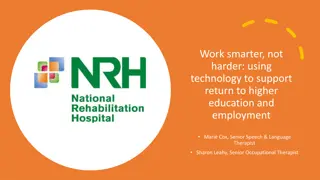Enhancing Public Access with Assistive Technology in ICT
Touch screens present barriers for individuals with disabilities, hindering access to essential information and services. The advancement of multi-mode accessible technology aims to address these challenges by incorporating features such as audible content navigation and highly tactile interfaces. Regulations and public expectations, including the UK Equality Act 2010 and the Americans with Disabilities Act 2010, emphasize the importance of designing ICT products and services that are accessible to all. By meeting these standards, organizations can ensure inclusivity and equal access for everyone. Language: English
Uploaded on Sep 07, 2024 | 3 Views
Download Presentation

Please find below an Image/Link to download the presentation.
The content on the website is provided AS IS for your information and personal use only. It may not be sold, licensed, or shared on other websites without obtaining consent from the author.If you encounter any issues during the download, it is possible that the publisher has removed the file from their server.
You are allowed to download the files provided on this website for personal or commercial use, subject to the condition that they are used lawfully. All files are the property of their respective owners.
The content on the website is provided AS IS for your information and personal use only. It may not be sold, licensed, or shared on other websites without obtaining consent from the author.
E N D
Presentation Transcript
Assistive Technology for Public Use ICT Peter Jarvis Senior Executive Vice President peterj@storm-interface.com Sita Southwest Airlines Embross United Airlines NCR Alaska Airlines NCR Frontier Airlines Embross - JetBlue Airlines
So whats the problem? Touch-screens create significant barriers for those with disabilities. Information and access to services denied. Legal and humanitarian obligations to ensure access. Let s make it as good as it can be for all customers The most common disability in the world today is an inability to read. This disability may be caused by physiological, cognitive, developmental, educational or cultural reasons . Peter Jarvis.
Multi-Mode Accessible Technology. Compliance with mandates is now required ICT developing faster than mandates can be written into law Emerging AI technology making ICT more accessible. How do we make ICT as accessible as it can be. Highly visible screen content Audible content navigation Highly tactile system interface Voice activation / recognition (AI) Biometrics, gesture, expression and facial recognition There are challenges to be addressed
Changing expectations. A personal quote from one participant in trials conducted by the RNIB. For the first time, I have been able to complete complex transactions at a kiosk without assistance or intervention from others. I was able to, plan a rail journey, select destinations, research fare classes and ticket prices, and then purchase tickets. I was also able to participate in an election using an electronic voting system. These tasks were completed using audible content navigation with tactile system controls. The technology exists! It is frustrating that all systems are not accessible in this way .
Regulations and public expectations UK Equality Act 2010 Europe Pending replacement of Disability Discrimination Act 2010 EN 301-549 mandates a comprehensive set of accessibility requirements for public procurement of ICT products and services in the EU. This mandate is now proposed as the basis for an internationally adopted standard, North America Americans with Disabilities Act 2010. Design for Accessibility. US Department of Transport: Air Carrier Access Act (ACAA) became effective during 2010 with implementation required to commence by Dec 2016. US Rehabilitation Act: Section 503 [Federal government contractors]. Section 504 [Rights in education, employment and other settings]. Section 508 [Requirements for electronic and information technology developed, maintained, procured or used by the Federal Government]. FCC: 21st Century Communications and Video Accessibility Act (CVAA), requiring communications services and products to be accessible to people with disabilities. Implemented December 2016. Other Territories United Nations Convention on the Rights of Persons with Disabilities (UNCRPD). W3C Web Content Accessibility Guidelines (WCAG) for international standards.























